Online Gather.town Pitches
Image Reconstruction V
Joint Annual Meeting ISMRM-ESMRMB & ISMRT 31st Annual Meeting • 07-12 May 2022 • London, UK

| Booth # | ||||
|---|---|---|---|---|
4710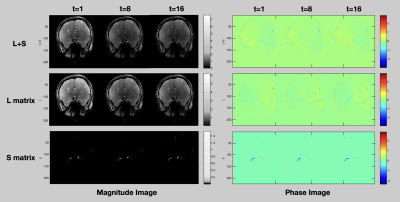 |
1 | Accelerating Cerebrovascular 4D Flow by Low-Rank and Sparsity Constraints at Ultra-High Field
Xueying Zhao1, Pierre-Francois Van de Moortele2, Ying-Hua Chu3, and He Wang1,4
1Institute of Science and Technology for Brain-inspired Intelligence, Fudan University, Shanghai, China, 2Center for Magnetic Resonance Research, University of Minnesota, minneapolis, MN, United States, 3MR Collaboration, Siemens Healthineers Ltd., Shanghai, China, Shanghai, China, 4Human Phenome Institute, Fudan University, Shanghai, China
Inspired by the success of low-rank and sparsity (L+S) representation in 4D flow MRI acceleration of great vessels (e.g. hearts or aortic), we managed to implement a generalized L+S reconstruction framework for cerebrovascular 4D flow at 7T. The iterative hard-thresholding approach was adopted instead of the popular used soft-thresholding method because we found soft-thresholding underestimated the reconstructed phase value while hard-thresholding well preserved the phase information. The L+S reconstructed magnitude and phase value at an acceleration factor of 10 is comparable to the fully sampled reference and represents less errors compared with other compressed sensing based approaches.
|
||
4711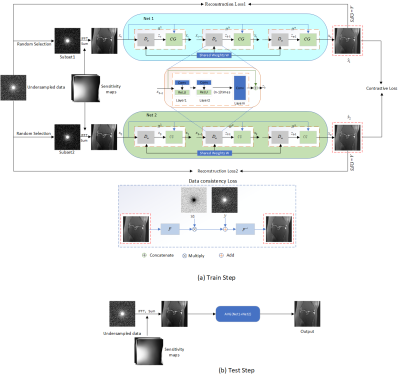 |
2 | Physics-based data-augmented deep learning without fully sampled dataset for multi-coil magnetic resonance imaging
Ruoyou Wu1, Chen Hu1, Cheng Li1, Wenxin Fan1, Hairong Zheng1, and Shanshan Wang1
1Paul C. Lauterbur Research Center for Biomedical Imaging, Shenzhen Institute of Advanced Technology, Chinese Academy of Sciences, Shenzhen, China
Self-supervised deep learning for MR reconstruction has shown high potential in accelerating MR imaging as it doesn’t need fully sampled dataset for model training. However, the performances of the current self-supervised methods are limited as they don’t take full utilization of the available under-sampled data. We propose a physics-based data-augmented deep learning method to enable faster and more accurate parallel MR imaging. Novel augmenting losses are calculated, which can effectively constrain the model optimization with better utilization of the collected dataset. Extensive experiments are conducted, and better reconstruction results are generated by our method compared to the current state-of-the-art methods.
|
||
4712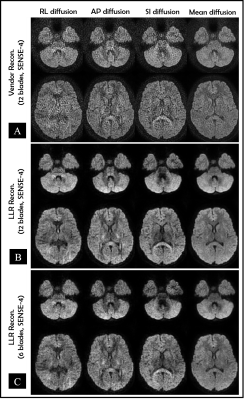 |
3 | Accelerated Propeller FSE-DWI with Locally Low Rank Regularized Reconstruction
Uten Yarach1, Suwit Saekho1, Kittichai Wantanajittikul1, Salita Angkurawaranon2, Chakri Madla2, Charuk Hanprasertpong3, and Prapatsorn Sangpin4
1Department of Radiologic Technology, Faculty of Associated Medical Science, Chiang Mai University, Chiang Mai, Thailand, 2Department of Radiology, Faculty of Medicine, Chiang Mai University, Chiang Mai, Thailand, 3Department of Otolaryngology, Faculty of Medicine, Chiang Mai University, Chiang Mai, Thailand, 4Philips (Thailand) Ltd., Bangkok, Thailand
Propeller FSE-DWI has been a method of choice in particular for Cholesteatoma. However, its natures such as prolong scan time, low signal-to-noise ratio (SNR), and phase variations among the blades have been challenging. Parallel imaging technique can be applied to reduce scan time, but phase estimation/correction is often compromised due to g-factor noise penalty. In this work, we develop an iterative reconstruction with locally low rank (LLR) regularization to maximize quality of propeller FSE-DWI images. As a result, LLR enable improving SNR up to SENSE factor of 4 compared to images obtained by vendor’s provided reconstruction engine.
|
||
4713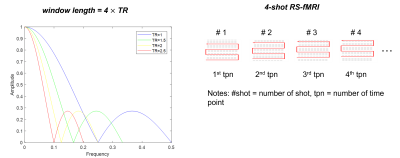 |
4 | The Effect of Sliding Window Reconstruction with Multiplexed-Sensitivity Encoding on Multi-shot Resting-State fMRI Data
Shihui Chen1, Chia-Wei Lee2, and Hing-Chiu Chang1,3
1Department of Diagnostic Radiology, The University of Hong Kong, Hong Kong, Hong Kong, 2GE Healthcare, Taiwan, Taiwan, 3Department of Biomedical Engineering, The Chinese University of Hong Kong, Hong Kong, Hong Kong
High-resolution 4-shot multi-echo resting-state fMRI (RS-fMRI) can be achieved by acquiring data in a sliding window manner, and thus the composite full k-space for MUSE reconstruction can be obtained by combining the segments from the consecutive time points. However, the sliding window operation may smooth the time courses and lead to a similar effect as applying a moving average filter. In this study, we aimed to investigate the effect of k-space data sharing from consecutive time points acquired with different TRs, and to determine a feasible TR for the acquisition and reconstruction scheme for high-resolution 4-shot multi-echo RS-fMRI with MUSE.
|
||
4714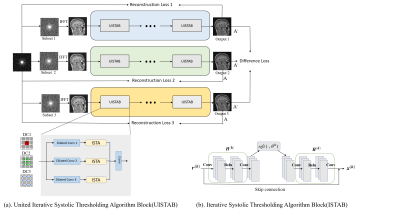 |
5 | SSTN: Self-supervised Triple-Network with Multi-scale Dilated-Convolution for Fast MRI Reconstruction
Yuekai Sun1, Jun Lv1, Weibo Chen2, He Wang3,4, and Chengyan Wang4
1School of Computer and Control Engineering, Yantai University, Yantai, China, 2Philips Healthcare, Shanghai, China, 3Institute of Science and Technology for Brain-inspired Intelligence, Fudan University, Shanghai, China, 4Human Phenome Institute, Fudan University, Shanghai, China
To solve the problem that fully-sampled reference data is difficult to acquire, we proposed a self-supervised triple-network (SSTN) for fast MRI reconstruction. Each pipeline of SSTN is composed of multiple parallel ISTA-Net blocks which consists of different scales dilated convolution layers. The results demonstrated that the proposed SSTN can generate better quality reconstructions than competing methods at high acceleration rates.
|
||
4715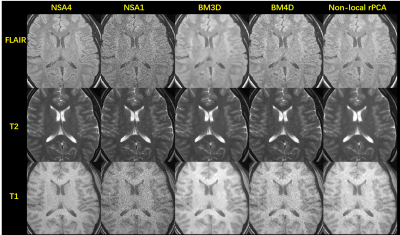 |
6 | Low field multi-contrast MRI denoising using robust PCA
Xinyu Ye1, Yuan Lian1, Hai Luo 2, Ziyue Wu 2, and Hua Guo1
1Center for Biomedical Imaging Research, Department of Biomedical Engineering, School of Medicine, Tsinghua University, Beijing, China, 2Marvel Stone Healthcare Co., Ltd.,, Wuxi, China Owing to hardware advancements, a resurgence of interest has emerged in low field MRI systems recently. However, the intrinsic low signal to noise ratio (SNR) due to the low magnetic field strength has hindered the acquisition of high-resolution images on low field MRI systems. Here we propose a non-local robust PCA-based method to jointly denoise multi-contrast images acquired on a 0.5 T MRI system. In-vivo brain data are used to test the proposed method. The results show that the proposed method outperforms BM3D and BM4D denoising methods. |
||
4716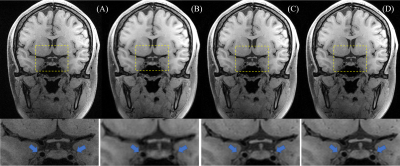 |
7 | Super-resolution MR Vessel Wall Images Using deep learning
Wenjing Xu1, Sen Jia1, Qing Zhu2, Yikang Li3, Hongying Zhang4, Shuai Shen1, Fuliang Lin1, Ye Li1, Dong Liang1, Xin Liu1, Hairong Zheng1, and Na Zhang1
1Paul C. Lauterbur Research Center for Biomedical Imaging, Shenzhen Institute of Advanced Technology, Chinese Academy of Sciences, Shenzhen, China, 2Faculty of Information Technology, Beijing University of Technology, Beijing, China, 3Department of computing,Imperial College London, London, United Kingdom, 4Department of Radiology, Northern Jiangsu People's Hospital, Jiangsu, China
To develop a super-resolution method based on the 3D high-resolution MR vessel wall images for generating high-resolution images from low-resolution, a 3D complex-valued super resolution (CVSR) neural network was proposed, which maintained complex algebraic structure of the original acquired images. CVSR was trained on 20 pairs of data sets and tested on 5 pairs. Ground truth with 0.44 mm were compared with Fourier interpolation method, EDSR with two real-valued channels and CVSR. Evaluations were performed using structural similarity (SSIM), peak signal-to-noise ratio (PSNR), and error map quality metrics. The CVSR achieved the best performance when compared with the other methods.
|
||
4717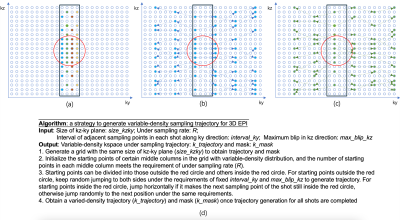 |
8 | A Novel Variable-Density Sampling Strategy for 3D Diffusion-Tensor Imaging with 3D-MUSER and Compressed Sensing
Xiaorui Xu1, Liyuan Liang1, Xiaoxi Liu2, and Hing-Chiu Chang3
1Department of Diagnostic Radiology, The University of Hong Kong, Hong Kong, Hong Kong, 2Department of Radiology and Biomedical Imaging, University of California San Francisco, San Francisco, CA, United States, 3Department of Biomedical Engineering, The Chinese University of Hong Kong, Hong Kong, Hong Kong
3D multi-slab multi-shot diffusion-weighted EPI can enable high-resolution diffusion-tensor imaging (DTI). Furthermore, in order to avoid the slab boundary artefacts, 3D-MUSER was proposed to enable 3D phase correction for effectively reconstructing nearly whole brain 3D DTI data acquired with only a single slab. Compressed sensing (CS) was also combined with 3D-MUSER to further reduce the scan time, but the previously proposed pseudo-random sampling strategy was still suboptimal for CS reconstruction. Therefore, we propose a novel variable-density k-space sampling strategy that is compatible with 3D-MUSER and able to achieve highly-accelerated and high-quality 3D DTI by taking the full advantage of CS.
|
||
The International Society for Magnetic Resonance in Medicine is accredited by the Accreditation Council for Continuing Medical Education to provide continuing medical education for physicians.